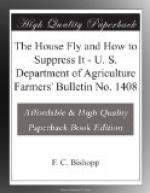CONSTRUCTION AND CARE OF STABLES.
In formulating rules for the construction and care of stables and the disposal of manure the following points must be taken into consideration. In the first place, the ground of soil-floor stables may offer a suitable place for the development of fly larvae. The larvae will migrate from the manure to the soil and continue their growth in the moist ground. This takes place to some extent even when the manure is removed from the stables every day. Even wooden floors are not entirely satisfactory unless they are perfectly water-tight, since larvae will crawl through the cracks and continue their development in the moist ground below. Water-tight floors of concrete or masonry, therefore, are desirable. Flies have been found to breed in surprising numbers in small accumulations of material in the corners of feed troughs and mangers, and it is important that such places be kept clean.
FLY-TIGHT MANURE PITS.
The Bureau of Entomology for a number of years has advised that manure from horse stables be kept in fly-tight pits or bins. Such pits can be built in or attached to the stable so that manure can be easily thrown in at the time of cleaning and so constructed that the manure can be readily removed. It is desirable that the manure be placed in these fly-proof receptacles as soon as possible after it is voided. The essential point is that flies be prevented from reaching the manure, and for this reason the pit or bin must be tightly constructed, preferably of concrete, and the lid kept closed except when the manure is being thrown in or removed. The difficulty has been that manure often becomes infested before it is put into the container, and flies frequently breed out before it is emptied and often escape through the cracks. To obviate these difficulties a manure box or pit with a modified tent trap or cone trap attached is desirable.
In order to retain the fertilizing value of manure to the greatest extent it is advisable that air be excluded from it as much as possible and that it be protected from the leaching action of rains. This being the case, there is really no necessity for covering a large portion of the top of the box with a trap, but merely to have holes large enough to attract flies to the light, and to cover these holes with ordinary conical traps, with the legs cut off, so, that the bottoms of the traps will fit closely to the box. The same arrangement can be made where manure is kept in a pit. If manure boxes or pits are kept fly tight they are satisfactory under farm or dairy conditions for the storage of manure during the busy season when it can not be hauled out daily.




